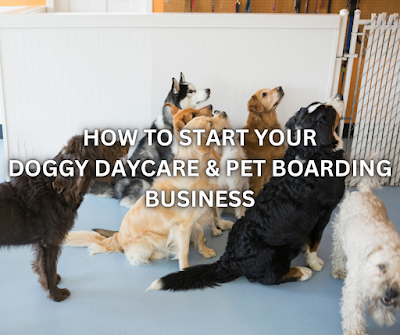This need is particularly true for busy professionals, frequent travelers, and those seeking safe pet socialization options during long workdays.
Doggy daycare and pet boarding businesses offer more than just a temporary shelter; they provide a nurturing environment, social interaction, and consistent care crucial for pets' well-being when their owners are away.
This has led to a burgeoning market for pet care services, opening up substantial opportunities for entrepreneurs passionate about animals.
However, starting a doggy daycare and pet boarding business involves more than a love for animals. It requires a strategic approach encompassing market understanding, facility management, staff training, and a commitment to the safety and health of the pets in your care.
This guide will delve into these aspects, providing a comprehensive roadmap to establish and grow a successful doggy daycare and pet boarding business. From understanding the market dynamics to creating a welcoming and safe environment for pets, we'll cover all the essential steps to help you turn your passion for pets into a thriving business venture.
Market Research and Analysis
This section provides a comprehensive look at how to analyze and interpret the pet care industry, know your target market, and study your competition, setting the foundation for a successful business.
Understanding the Pet Care Industry and Current Trends
Delving into the pet care industry's current landscape is crucial. Research should include analyzing industry reports, growth rates, and potential future trends. Understanding these elements helps gauge the market's potential and identify gaps your business can fill.This step lays the foundation for making informed decisions about your services, pricing, and marketing strategies.
Identifying Your Target Market and Competition
Identifying your target market involves understanding your potential customers' demographics, pet care needs, and preferences.
Simultaneously, a thorough analysis of the competition helps understand what others in your area offer. Look at their services, pricing, strengths, and weaknesses.
This knowledge will guide you in differentiating your business and tailoring your services to meet specific needs that are not currently addressed.
Assessing Local Demand and Setting Realistic Goals
Assessing the local demand for doggy daycare and pet boarding services is critical. This assessment includes understanding the number of pet owners in your area, their lifestyle, and their willingness to pay for such services.It's also essential to set realistic business goals based on this demand. Consider factors like the local economy, pet ownership rates, and the community's average income to ensure your business goals are achievable and sustainable.
Business Planning
Developing a Clear Business Plan
Creating a business plan is the first critical step in establishing your doggy daycare and pet boarding business. This plan should outline your mission statement, business objectives, and strategies for achieving them.It serves as a roadmap, guiding every decision you make, from financial management to marketing. Ensure your plan is detailed, realistic, and flexible enough to adapt to changing market conditions.
Determining Services Offered
Decide on the range of services your business will offer. This might include daily care, long-term boarding, grooming services, training sessions, or specialized care for pets with specific needs.Each service should align with your target market's demands and your business's capabilities. Consider what makes your offerings unique and how they will stand out in the competitive landscape.
Financial Planning
Financial planning involves estimating startup costs, setting pricing strategies, and projecting revenue. It's essential to account for expenses like facility leasing, renovations, equipment, staff salaries, and marketing.Your pricing strategy should reflect the quality of your services, market rates, and what your target customers are willing to pay. Additionally, projecting revenue helps set financial goals and measure the business's growth over time.
Sample Business Plan Format
This sample Doggy Daycare and Pet Boarding Business Plan format provides a comprehensive blueprint for entrepreneurs, ensuring they cover all critical aspects of business planning for their doggy daycare and pet boarding venture.- Executive Summary
This section summarizes your business concisely, including its mission statement, the services offered, and key objectives. It should also sum up your unique value proposition and briefly outline your goals and vision for the business.
- Company Description
Detail the specifics of your business in this section. Describe the nature of your doggy daycare and pet boarding services, its needs, and why it will succeed. Add information about the business structure, ownership, and the legal environment in which it operates.
- Market Analysis
Present an analysis of the pet care industry, including trends, target market demographics, and a thorough competitive analysis. This section should demonstrate your understanding of the market and how your business will fit.
- Organization and Management
Describe the organizational structure of your business. If applicable, include information about the owners, management team, and board of directors. Outline the roles, responsibilities, and qualifications of each team member.
- Services Offered
Clearly outline the services your business will provide. This may include daycare, boarding, grooming, training, and specialty services. Explain how these services will meet the needs and preferences of your target market.
- Marketing and Sales Strategy
Briefly describe how you plan to attract and retain customers in this section. This should include your marketing and advertising strategies, sales tactics, and a plan for building customer relationships and loyalty.
- Funding Request
If you seek funding, specify the amount needed over the next five years and how it will be used. Outline future financial plans, including debt repayment or selling your business.
- Financial Projections
Provide detailed financial forecasts for three to five years, including projected income statements, balance sheets, etc. These should include realistic assumptions about revenue growth and expense management.
- Appendix
Include additional information that supports your business plan. This could be resumes of key personnel, legal documents, product images, marketing materials, or any other relevant information.
This section underscores the importance of adhering to legal standards and protecting your business, staff, and the animals in your care with appropriate insurance policies.
Legal Requirements and Insurance
Navigating Legal Requirements
Understanding and complying with legal requirements is crucial for setting up a doggy daycare and pet boarding business. This involves acquiring the necessary licenses and permits to operate legally in your region.Research local and state regulations related to pet care businesses, including zoning laws, health and safety standards, and any specific requirements for pet boarding facilities. Ensuring compliance from the outset helps avoid legal complications and establishes your business as a trustworthy and professional entity.
Insurance for Protection
Investing in the right insurance protects your business, staff, and the pets under your care. General liability insurance must cover incidents like injuries or property damage.Additionally, consider obtaining property insurance for your facility and workers' compensation for your employees. For added protection, specialized pet care insurance can cover unique risks associated with pet boarding and daycare operations.
Consulting with an insurance agent specializing in pet care businesses can provide tailored advice for your specific needs.
Choosing a Suitable Location
Evaluating Location Factors
The correct location for a doggy daycare and pet boarding business involves several critical considerations. Accessibility for pet owners, proximity to residential areas, and visibility are crucial.The size and layout of the property are also important, as they need to accommodate various facilities like play areas, kennels, and potentially grooming stations. Safety, noise levels, and adherence to local zoning laws for animal care facilities are crucial aspects to consider.
Designing the Space for Optimal Care
The facility's design should focus on creating a comfortable and stimulating dog environment. This includes having dedicated areas for play, rest, and feeding activities.The layout should facilitate easy supervision and interaction with the pets. Consider durable, easy-to-clean flooring materials, and ensure proper ventilation and lighting to maintain a healthy environment.
Addressing Health and Safety Standards
Complying with health and safety standards is essential in the facility's design. Key elements include secure fencing for outdoor areas, effective waste management systems, and the use of non-toxic, pet-friendly materials.Guaranteeing the safety and well-being of pets and staff in the design and layout of the facility is not just a legal requirement but also a factor that significantly influences the business's reputation and success.
Facility Setup and Equipment
Essential Equipment and Supplies
Setting up a doggy daycare and pet boarding facility requires carefully considering the equipment and supplies needed to ensure a safe, comfortable, and engaging environment. This includes durable kennels or crates, bedding, feeding bowls, and various toys for different play activities.Additionally, grooming supplies, first aid kits, and cleaning equipment are essential for maintaining hygiene and health standards.
Creating a Safe and Stimulating Environment
The facility should provide a stimulating yet safe space for dogs. This involves having designated areas for various activities, such as play zones, quiet rest areas, and eating spaces.The layout should facilitate easy movement of pets and staff while ensuring all areas are easily visible for supervision. Attention should be paid to creating a mentally and physically enriching space for the pets.
Implementing Technology for Efficiency and Security
Incorporating technology can significantly enhance the efficiency and security of a pet boarding facility. This can include surveillance cameras for monitoring, electronic check-in and check-out systems for pets, and climate control systems to maintain optimal conditions.Additionally, well-integrated management software can streamline operations such as scheduling, billing, and keeping track of each pet's care details.
Staffing and Training
Hiring Qualified Staff
Its staff is the backbone of a successful doggy daycare and pet boarding business. Hiring individuals who are passionate about animals and possess the necessary skills and qualifications is crucial.This includes finding employees who have experience in pet care, are knowledgeable about animal behavior, and possess strong customer service skills. Background checks and references are essential to ensure the safety and reliability of the staff.
Training for Excellence
Once the team is assembled, comprehensive training is essential. This training should cover pet care basics, emergency response procedures, first aid for animals, and effective communication with pet owners. Regular training sessions can keep the staff updated on the best practices in pet care and handling, ensuring the highest quality of service.Staff Management and Scheduling
Effective staff management involves creating efficient schedules that ensure the facility is adequately staffed while considering the employees' work-life balance.This includes managing shifts for full-time and part-time staff, planning for peak times, and ensuring that each staff member is trained to handle multiple roles if needed. Effective scheduling contributes to a smooth operation and a positive work environment.
Health and Safety Protocols
Establishing Health Checks and Vaccination Requirements
A fundamental aspect of running a doggy daycare and pet boarding facility is ensuring the health and safety of all pets. This starts with establishing strict health checks and vaccination requirements for every pet admitted.Clear policies on required vaccinations, flea and tick prevention, and overall health checks should be communicated to pet owners. This protects the pets in your care and maintains a safe and healthy environment within the facility.
Emergency Procedures and Pet Health Issues
Being ready for emergencies is crucial. Create and implement a comprehensive plan for handling various health emergencies, such as injuries, sudden illnesses, or other pet health crises.This includes having a protocol for immediate response, access to veterinary services, and clear communication with pet owners. Employees must be trained to know signs of distress or illness in pets and the appropriate actions to take in emergencies.
Hygiene and Cleanliness Standards
Maintaining hygiene and cleanliness standards is essential for the well-being of pets and staff alike. This includes regularly cleaning and disinfecting kennels, play areas, and shared spaces.Establish daily cleaning, waste management, and laundry routines to ensure a clean and odor-free environment. Pet-safe cleaning products and maintaining proper ventilation are vital to achieving these standards.
This section explores strategic approaches to building a solid brand, utilizing diverse advertising platforms, and fostering enduring relationships with your clientele.
Marketing and Promotion
Building a Brand Identity and Online Presence
In today's digital age, having a solid brand identity and online presence is crucial for the success of a doggy daycare and pet boarding business. This involves creating a memorable brand that resonates with your target audience, including a distinctive logo, color scheme, and brand messaging that reflects the ethos of your business.Establishing a good online presence through a professional website, active social media profiles, and online listings is essential to reach potential customers and build brand recognition.
Effective Advertising Strategies
Developing effective advertising strategies is vital to attracting customers. This might include leveraging social media platforms for targeted ads, engaging in local community events, or forming partnerships with local pet-related businesses.Traditional marketing methods like flyers, local newspaper ads, and community bulletin boards are also beneficial. Tailoring your advertising efforts to the preferences and habits of your target audience will increase the effectiveness of your marketing.
Customer Relationship Management
Having good relationships with your customers is vital. This can be done through excellent customer service, regular communication, and feedback solicitation.A customer relationship management (CRM) system can help track customer interactions, manage inquiries, and personalize the service experience. Encouraging word-of-mouth referrals and offering loyalty programs or incentives can strengthen customer relationships and foster a loyal client base.
Managing Operations
Daily Operational Workflow
Efficient daily operations are the backbone of a successful doggy daycare and pet boarding business. This includes managing the check-in and check-out processes, overseeing feeding schedules, organizing playtime and rest periods, and ensuring consistent supervision of the pets.Streamlining these daily tasks through effective workflow management ensures a smooth running of the facility, enhances pet care, and improves customer satisfaction.
Customer Service Excellence and Communication
Providing exceptional customer service is vital to building a positive reputation and retaining clients. This involves clear and regular communication with pet owners, addressing their concerns promptly, and providing updates about their pets' well-being.Training staff in customer service skills and developing a responsive communication system, such as a dedicated phone line or email for inquiries, can significantly enhance the customer experience.
Record-keeping and Financial Management
Maintaining accurate records and efficient financial management is crucial for the long-term sustainability of the business. This includes keeping detailed descriptions of each pet's care, health information, and specific requirements and managing bookings, billing, and payments.Financial management software can help track expenses, revenue, and profit margins, enabling informed decision-making for business growth.
Expanding Your Business
Strategies for Growth and Scalability
It's essential to have a clear strategy for expansion to ensure the long-term success and growth of your doggy daycare and pet boarding business.This can include diversifying services, such as offering specialized care for different types of pets, additional grooming services, or advanced training programs.
Another strategy could be expanding the physical space of your facility to accommodate more pets or upgrading amenities to attract a broader client base. Assessing market trends and customer feedback can guide your expansion decisions effectively.
Diversifying Services and Revenue Streams
Introducing or improving new services can significantly enhance your business's appeal and profitability. Consider adding unique offerings like pet taxi services, in-home pet sitting, or partnering with veterinary services.Exploring additional revenue streams, such as selling pet products or hosting pet-related events, can contribute to business growth. Diversification not only increases revenue but also helps in mitigating risks associated with market fluctuations.
Building Partnerships and Community Involvement
Strategic partnerships with local pet businesses, veterinarians, and community organizations can open new expansion opportunities. Participating in community events, sponsoring local pet-friendly activities, and engaging in collaborations can enhance your business's visibility and reputation.Building a strong community presence can lead to increased referrals and a loyal customer base, which are crucial for sustainable growth.
Challenges and Solutions
Identifying Common Obstacles
Running a doggy daycare and pet boarding business comes with unique challenges. These may include managing high operational costs, handling complex animals, maintaining high occupancy rates, and ensuring consistent quality of care.Awareness of these potential obstacles is the first step towards addressing them effectively.
Common Obstacles in Running a Doggy Daycare and Pet Boarding Business
In a doggy daycare and pet boarding business, some common obstacles include:1. High Operational Costs: Running such a business can be costly due to expenses like rent, utilities, staff salaries, insurance, and maintenance. Managing these costs effectively while maintaining high-quality services can be challenging.
2. Handling Difficult Animals: Not all pets are easy to manage. Dealing with aggressive, anxious, or special-needs pets requires additional skills and resources, which can be challenging for the staff.
3. Maintaining High Occupancy Rates: Ensuring a steady flow of customers, especially during off-peak seasons, is crucial for profitability. This requires effective marketing and customer retention strategies.
4. Quality of Care Consistency: Providing consistent and high-quality care to all pets, regardless of their size, temperament, or special needs, is essential but can be challenging to maintain, especially with many pets.
5. Staff Training and Retention: Finding and retaining skilled staff passionate about animal care and providing them with continuous training is crucial but can be challenging.
6. Regulatory Compliance: Keeping up with and adhering to various local and state pet care, health, and safety regulations can be complex and demanding.
7. Customer Expectations: Meeting and exceeding pet owners' diverse and evolving expectations, who often consider their pets as family members, requires ongoing attention and adaptation.
8. Health and Safety Risks: Maintaining pets' and staff's health and safety, managing disease outbreaks, and dealing with emergencies are constant challenges.
Strategies for Overcoming These Challenges
It's essential to have a well-thought-out strategy to overcome these challenges. This can include implementing cost-effective operational practices, providing ongoing staff training in animal behavior and care, adopting dynamic marketing strategies to boost occupancy during off-peak seasons, and maintaining rigorous quality control measures.Additionally, seeking customer feedback and staying adaptable to the market's changing needs can aid in continuous improvement.
Staying Updated with Industry Trends
Remaining informed about the pet care industry's latest trends and innovations is crucial. Attending industry conferences, participating in professional networks, and subscribing to relevant publications can provide insights into new approaches and technologies.Staying updated helps anticipate market changes, adopt best practices, and continuously enhance your service offerings.
Embarking on a Rewarding Journey in Pet Care
Encouragement for Potential Entrepreneurs
Stepping into the world of pet care entrepreneurship is a journey fueled by passion and commitment. The path may present challenges, but the fulfillment derived from creating a successful space that caters to the well-being of pets and eases the minds of their owners is unparalleled.This guide aims to give you the knowledge and confidence needed to establish a standout business in the dynamic pet care industry. With thorough preparation, a willingness to learn and adapt, and a deep love for animals, your Doggy Daycare and Pet Boarding Business Venture is poised for success and meaningful impact.



























0 comments:
Post a Comment